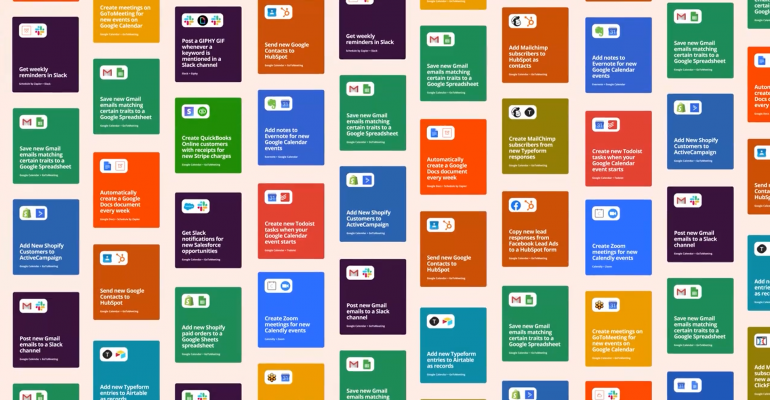Automating workflow processes is a way to ensure repetitive tasks get done in a consistent and timely way. There are now a number of end-user tools that break automation out of the developer to-do list and let workers offload their tedious tasks. Services like Zapier, IFTTT, and Power Automate provide building blocks that require little to no coding to automate repetitive processes. Ultimately, these no-code automation services save time and improve the flow of information across teams so they can be more responsive to customer inquiries.
The first part of this series will answer the question, “What is Zapier?”
The Zapier service is accessed via a modern web browser.
What Is Zapier? Master Its Terminology
This browser-based service allows end users to craft step-by-step workflows incorporating multiple web applications and services. It can be thought of as a translator of Web APIs, but for the end user, it’s a way to plot out how to take data from one or more sites, then process it using one or more tools to get a result.
When working through the documentation for the service, it helps to speak the lingo.
Zaps: A “zap” is Zapier’s term for an automated workflow. A Zapier workflow is typically comprised of multiple steps: first, a trigger event, and then subsequent actions spring from the trigger. The completion of these actions is referred to as Tasks.
Sub-Zap: A Sub-Zap is a Zap that is included in another Zap to perform any action step. It’s basically a little task that can be incorporated into workflows. For example, if a Zapier user is planning to build multiple workflows that require a step where customer query results are retrieved from Google Sheets, they could write a Sub-Zap that identifies a trigger event – an app making query to the customer data in the Google Sheets app, in this case – and defines a workflow around it, i.e. successfully completing the query and exporting the results to a chosen application. Once the Sub-Zap is built and tested, it can be incorporated into other Zaps so the person putting together workflows does not have to repeatedly define the same process every time they write a new Zap.
Tasks: Zapier Tasks refer to the completion of an action step, a successful filter step, successful use of a path rule, or the call to or return from a Sub-Zap.
Update Cycle: The time period between Zapier checking the services in a client Zap for new data.
Formatters: Used to convert text, numbers, or other data into users desired format for use.
Webhooks: These are automated functions sent between apps that push data from one app to another, often as part of a workflow to move data from one cloud-based service to another.
Custom Logic – Paths: These allow user to create workflows with the ability to perform different actions according to different conditions based on conditional and if/then logic.
Auto Replay: Zapier will attempt to re-try to execute a failed Task in a Zap up to five times.
Premium Apps: A subset of apps on Zapier, currently totaling 65 apps out of more than 3,000 on Zapier. Some examples include Zendesk, Salesforce, and Dynamics 365 CRM, and Google Groups.
What Is Zapier: How Services Connect Via Integrations
The various products and services that Zapier can connect with are referred to as Integrations.
Zapier’s current library of Zapier Integrations includes more than 3,000 apps. However, in order for users to access some of the services, Zapier requires a so-called premium subscription.
Zapier works with cloud storage and file management services from all the usual vendors, but access to Amazon S3 is only available to premium subscribers, for example.
The library of apps has a solid search capability to make finding key apps and services very straight forward among the extensive Zapier Integrations library available.
How to Create a Workflow: Pre-formatted and Homemade
In addition to the create-your-own Zaps that users can customize to their own routine work tasks, Zapier has pre-formatted Zaps called “templates” that illustrate common, easily-automated workflows like communicating data entry updates to interested parties or sharing data to a customer management service. They are customizable so that they can fit a specific organizational workflow where needed.
How to Sign Up for Zapier
Users can connect existing Microsoft, Facebook, Google accounts – or use a separate email account – to access the Zapier service.
What It Costs to Use Zapier
Zapier has a range of plans and pricing that covers from individuals to large enterprise organizations. The plans also scale up the available service features based on these subscription categories. Prices are current as of August 2021.
Free: Includes five single step Zaps, a 15-minute update cycle, access by one user, and 100 Tasks per month.
Starter: Includes 20 multi-step Zaps, a 15-minute update cycle, three premium apps, filters, formatters, connections via Webhooks, access by one user, and 750 Tasks per month. Cost is $19.99 monthly if billed annually or $29.99 month-to-month.
Professional: Includes unlimited multi-step Zaps, a two-minute update cycle, unlimited premium apps, filters, formatters, connections via Webhooks, custom logic, auto-replay, access by one user, and 2,000 Tasks per month. Cost is $49 monthly if billed annually or $73.50 month-to-month.
Team: Includes all features from Professional tier plus a one-minute update cycle, unlimited users, folder permissions, premier support, shared app connections, shared workspace, and 50,000 Tasks per month. Cost is $299 monthly if billed annually or $448.50 month-to-month.
Company: Includes all features from Team tier plus advanced admin permissions, user provisioning, app restrictions, single sign-on, custom data retention, account consolidation, live training with customer success team, and 100,000 Zapier Tasks per month. Cost is $599 monthly if billed annually or $898.50 month-to-month.
Upgrades and downgrades are allowed at any time in the billing cycle.





